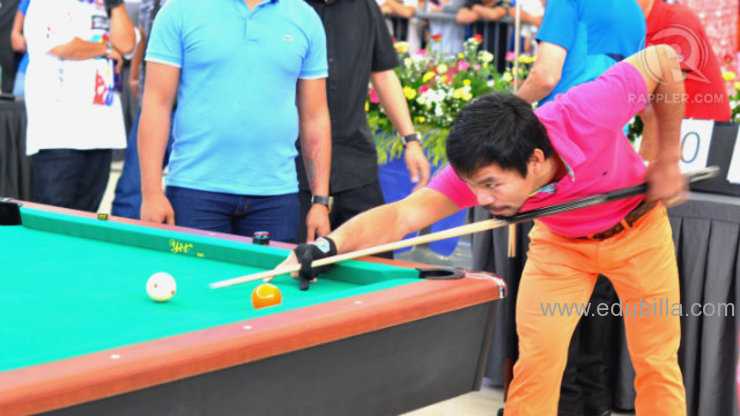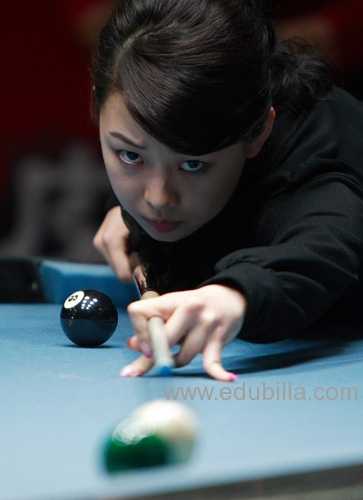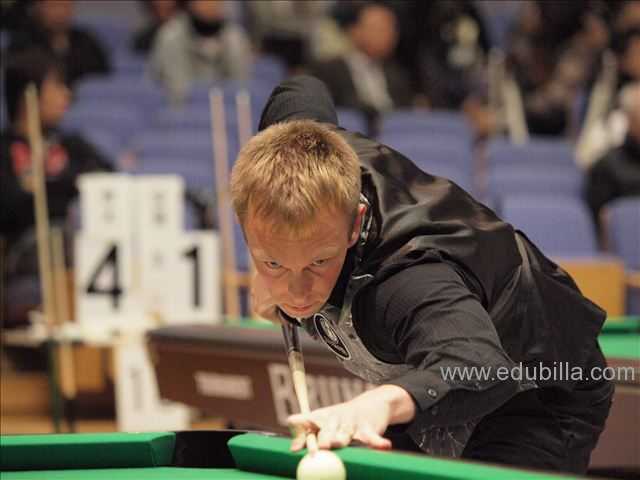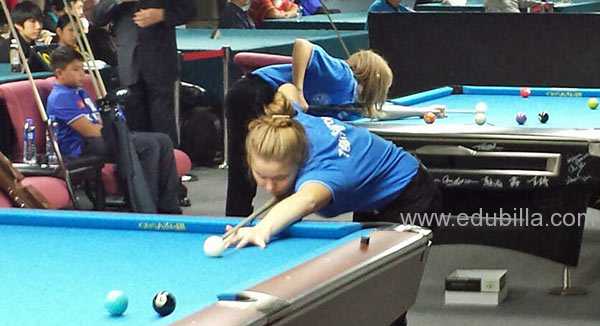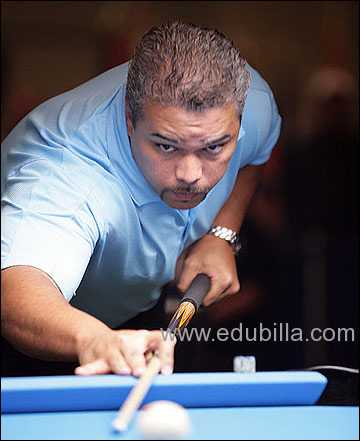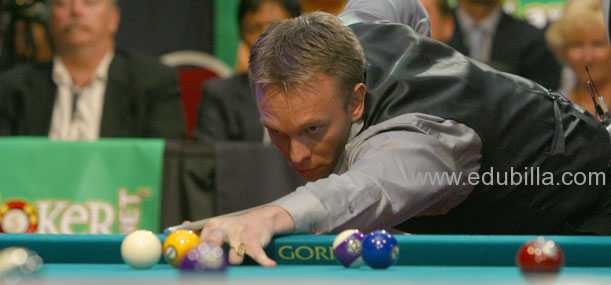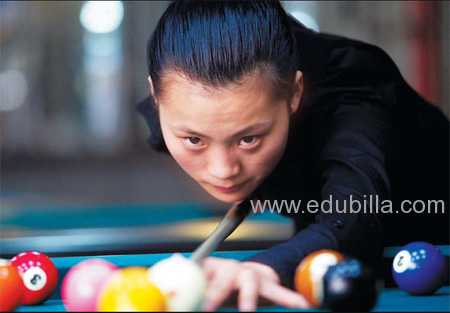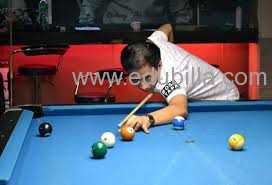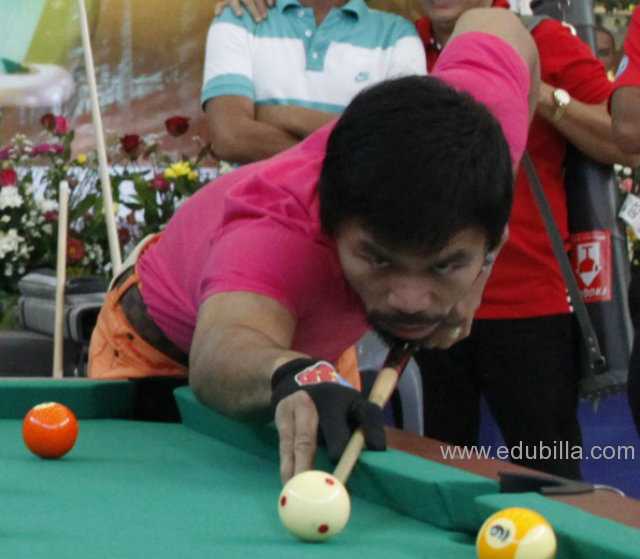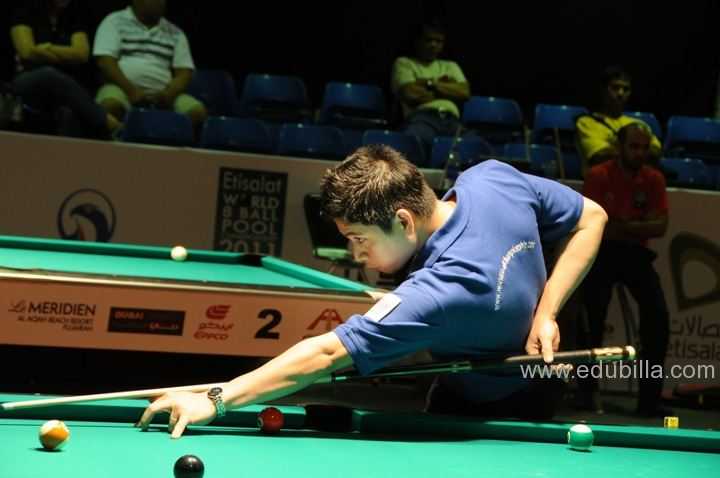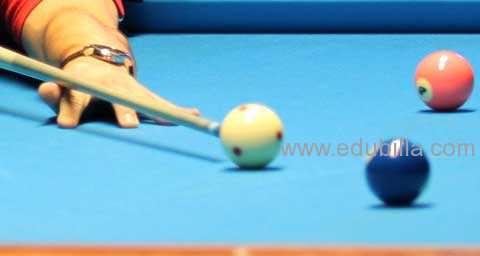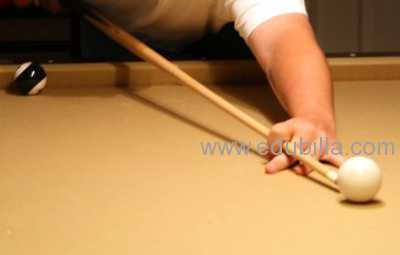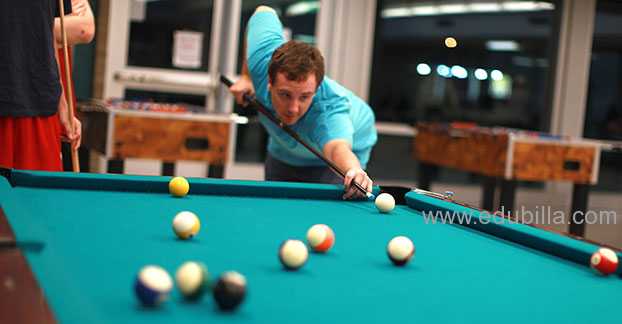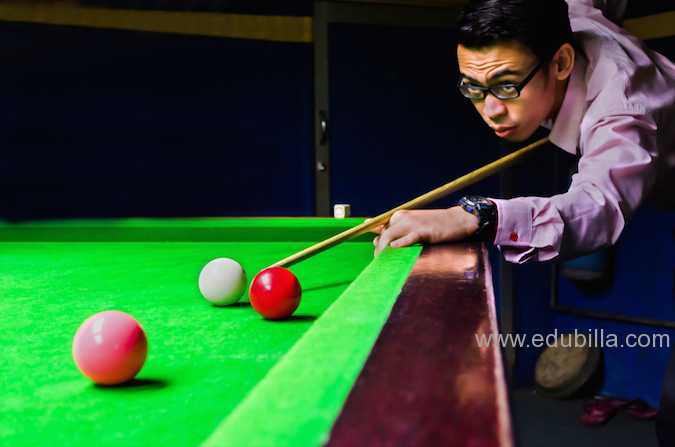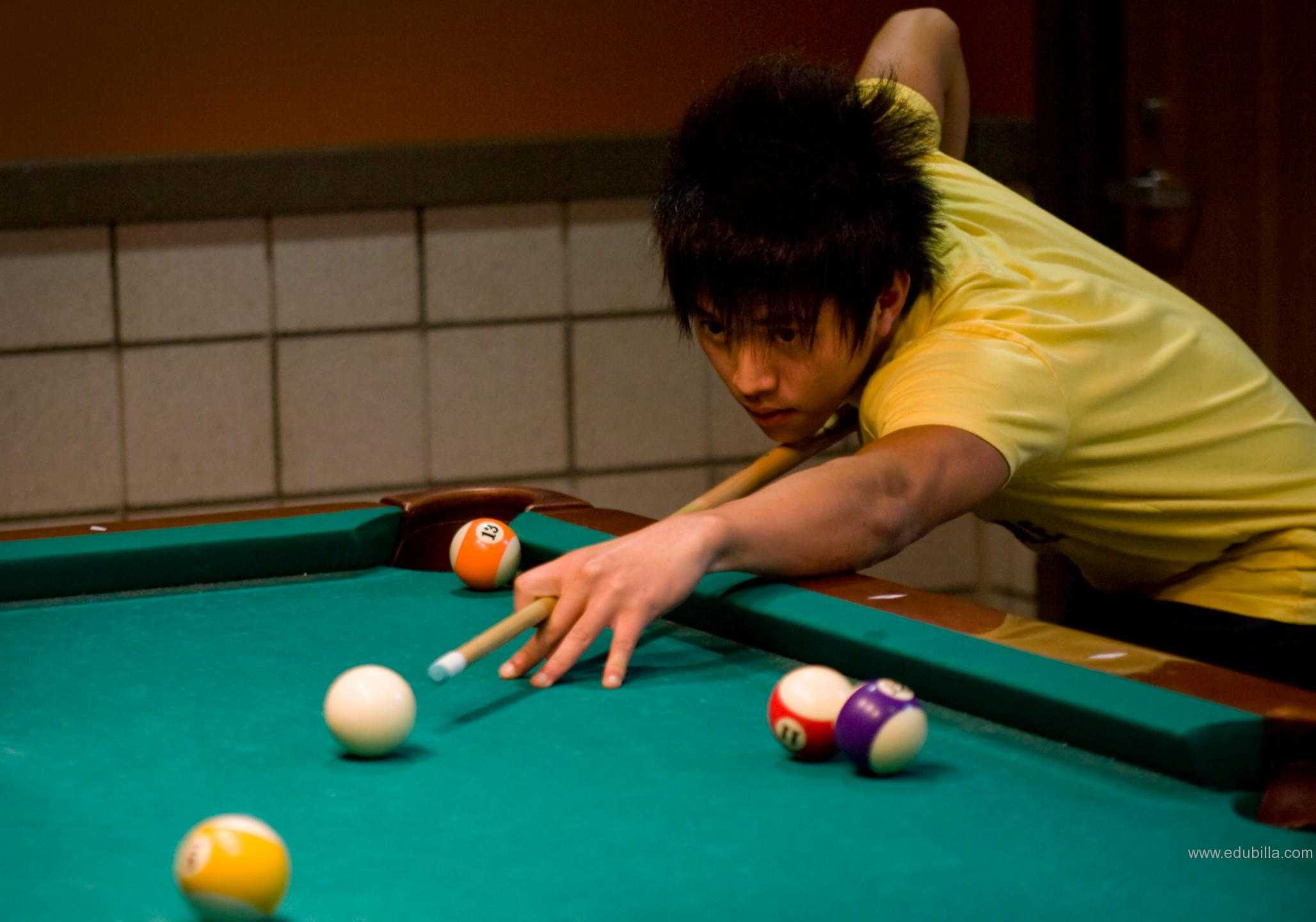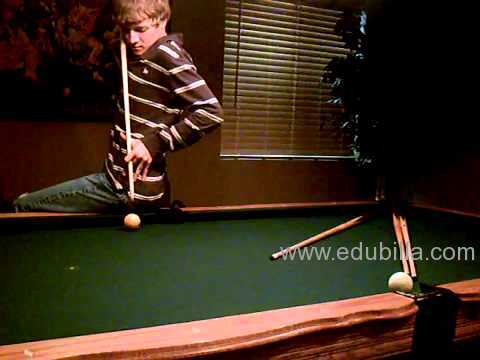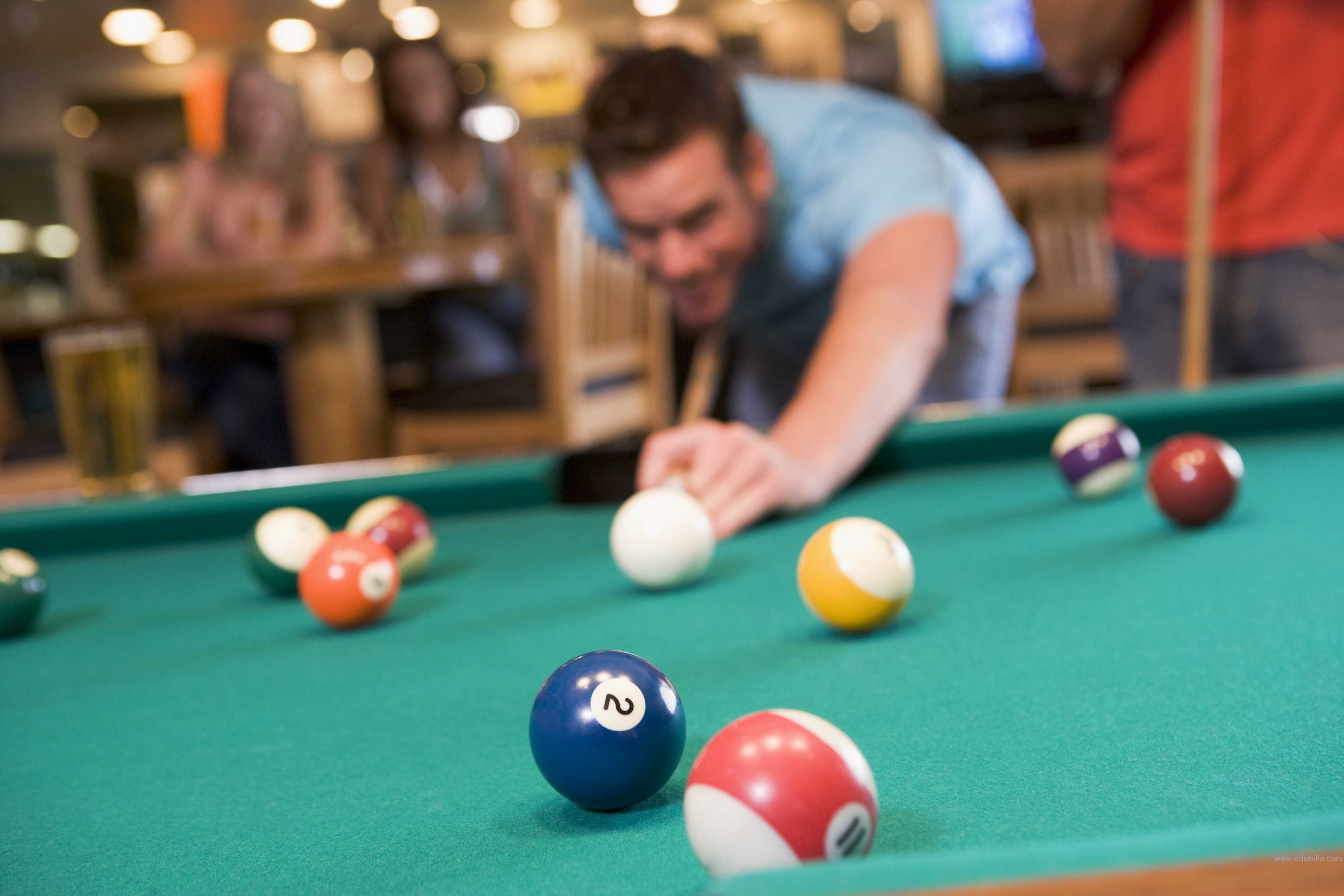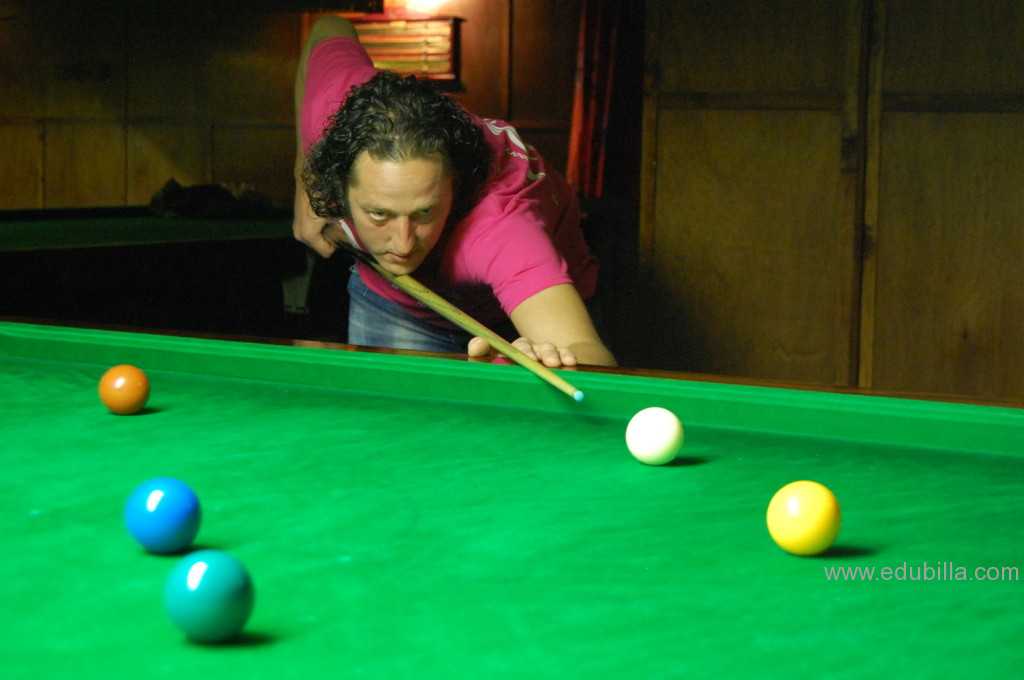
Overview Of Pool (cue sports)
Pool, also more formally known as pocket billiards (mostly in North America) or pool billiards(mostly in Europe and Australia), is the family of cue sports and games played on a pool table having six receptacles called pockets along the rails, into which balls are deposited as the main goal of play. Popular versions include eight-ball and nine-ball. An obsolete term for pool is six-pocket.
There are also hybrid games combining aspects of both pool and carom billiards, such as American four-ball billiards, cowboy pool and bottle pool.
There are hundreds of pool games. Some of the more well known include eight-ball, nine-ball, ten-ball, straight pool, one-pocket and bank pool.
Game types:
Eight-ball:
8-Ball Pool, also known as solids and stripes or spots and stripes, is a pool game famous around the world and the subject of international professional and beginner competitions. With an average 8-ball table playing surface of approximately 9X4.5 feet, the game is played with 16 balls – A cue ball, seven striped, seven solid-colored and the black 8 ball. The balls are scattered with a break shot, and the players are assigned either the group of solid balls or the stripes, depending on which team pockets which ball. The ultimate objective of the game is to pocket the 8 ball in a ‘called’ pocket. This can only be done after all of the balls from a player’s assigned group have been cleared from the table.
Nine-ball:
9-Ball Pool, on the other hand is a newer and more modern version of pool, with historical roots dating back to the 1920s. The game originated in the United States and has, over the last few decades, become a popular choice in leagues and tournaments owing to its quick pace. The game is played on a pocket billiards table with six pockets and ten balls. The cue ball is struck to hit the lowest numbered ball on the table. Each of these balls are prominently colored and numbered from 1 to 9. The objective of the game is to legally pocket the 9-ball.
Three-ball:
A variant using only three balls, generally played such that the player at turn continues shooting until all the balls are pocketed, and the player to do so in the fewest shots wins. The game can be played by two or more players. Dispenses with some fouls common to both nine- and eight-ball.
One-pocket:
One-pocket is a strategic game for two players. Each player is assigned one of the corner pockets on the table. This is the only pocket into which he can legally pocket balls. The first player to pocket the majority of the balls (8) in his pocket wins the game. The game requires far more defensive strategy than offensive strategy, much unlike eight-ball, nine-ball, or straight pool. Most times, accomplished players choose to position balls near their pocket instead of trying to actually pocket them. This allows them to control the game by forcing their opponent to be on defense instead of taking a low percentage shot that could result in a loss of game. These low percentage shots are known as "flyers" by one-pocket aficionados.
Bank pool:
Bank pool has been gaining popularity in recent years. Bank pool can be played with a full rack (can be a long game), but is more typically played with nine balls (frequently called "nine-ball bank"). The balls are racked in nine-ball formation, but in no particular order. The object of the game is simple: to be the first player to bank five balls in any order (eight balls when played with a full rack). Penalties and fouls are similar to one pocket in that the player committing the foul must spot a ball for each foul. This must be done before the incoming player shoots.
Game Rules
The World Pool-Billiard Association (WPA) rules contained in this handbook are the official rules used at all CCS Championship events. Rules used in local league play may be different.
WPA World Rules
At the 2007 General Assembly of the World Pool-Billiard Association (WPA), conducted on November 30 in Willingen, Germany, the delegates approved the following restructured version of the rules which were meant to be much easier to read.
The “new” version of the world-standardized rules officially took effect on January 1, 2008 among the various continental confederations and national federations which follow these rules of play. A 5-year moratorium on any further rule changes is typically followed.
POOL CUE SPECIFICATIONS:
Width of Tip: . . . . .No minimum / 14 mm. maximum
Weight: . . . . . . . . .No minimum / 25 oz. maximum
Length: . . . . . . . . .40 inches minimum / no maximum
The cue tip may not be of a material that can scratch or damage the addressed ball. The cue tip on any stick must be composed of a piece of specially processed leather or other fibrous or pliable material that extends the natural line of the shaft end of the cue and contacts the cue ball when the shot is executed.
The ferrule, if of a metal material, may not be more than 1 inch in length.
2. Nine Ball
Nine ball is played with nine object balls numbered one through nine and the cue ball. The balls are played in ascending numerical order. The player legally pocketing the nine ball wins the rack.
3. Eight Ball
Eight ball is played with fifteen numbered object balls and the cue ball. The shooter’s group of seven balls (one through seven or nine through fifteen) must all be off the table before he attempts to pocket the eight ball to win. Shots are called.
4.Continuous Pool
Continuous world-standardized rules at www.americancuesports.org.
5. Black Ball
See Black Ball world-standardized rules at www.americancuesports.org.
6. Fouls
The following actions are fouls at pool when included in the specific rules of the game being played. If several fouls occur on one shot, only the most serious one is enforced. If a foul is not called before the next shot begins, the foul is assumed not to have happened.
Equipments Need For Pool (cue sports)
Pool or pocket billiards (as the sport's governing body calls it) is played on a six pocket table. Modern pool tables generally range in size from 3.5 feet (1.07 m) by 7 feet (2.13 m), to 4.5 feet (1.37 m) by 9 feet (2.74 m).
The balls range from 2.25 inches (57.15 mm) in diameter to 2.375 inches (60.33 mm) in diameter.Under the WPA/BCA (see below) equipment specifications, the weight may be from 5.5 to 6 oz. (156–170 g) with a diameter of 2.25 in. (57.15 mm), plus or minus 0.005 in. (0.127 mm). Modern coin-operated pool tables generally use one of three methods to distinguish and return the cue ball to the front of the table while the numbered balls return to an inaccessible receptacle until paid for again: the cue ball is larger and heavier than the other balls, or denser and heavier, or has a magnetic core.
Modern cue sticks are generally 58.5 inches (148.6 cm) long for pool while cues prior to 1980 were designed for straight pool and had an average length of 57.5 inches (146.1 cm). By comparison, carom billiards cues are generally shorter with larger tips, and snooker cues longer with smaller tips.
History Of Pool (cue sports)
The History of billiards is long and very rich. The game has been played by kings and commoners, presidents, mental patients, ladies, gentlemen, and hustlers alike. It evolved from a lawn game similar to the croquet played some-time during the 15th century in Northern Europe and probably in France. Play moved indoors to a wooden table with green cloth to simulate grass, and a simple border was placed around the edges. The balls were shoved, rather than struck, with wooden sticks called "maces." The term "billiard" is derived from French, either from the word "billart", one of the wooden sticks, or "bille", a ball.
Pool – this term refers to a variety of pocket billiards games, including eight, nine and 10-ball, as well as straight pool. The tables used are between seven and nine feet in length and have six pockets.
Origins in the outdoors:
The origin of cue sports can be traced back to the 14th Century, and it is believed that they began life as outdoor games played on grass, involving hitting the balls with sticks. This suggests that they share an origin with games such as croquet, trucco, and even golf, with a version of billiards resembling croquet having been played as far back as the 1340s.
The tables had pockets added, leading to the development of games like straight, eight-ball, nine-ball and 10-ball pool. However, cue games were still mostly played by members of the nobility and gentry in France and England, despite the Industrial Revolution in the 18th Century contributing to the more widespread manufacture and availability of the materials. It was also around this time that the cue, as we know it today, was invented – with its name deriving from the French word ‘queue’ which means tail.
Pool joins the cue:
The success of professional snooker during this period had a knock-on effect for other cue sports, with professional nine-ball pool also getting its own World Championship tournament. Both eight and nine-ball pool had long been extremely popular in the US, but it was not until 1990 that the World Pool-Billiard Association (WPBA) sanctioned the creation of the Nine-Ball Championship. This was subsequently followed, in 2004, by an Eight-ball World Championship. Pool is widely played in the UK, particularly in pubs, but has never attained the same popularity as a sport that snooker enjoys; however it remains far more popular in the US and parts of the Far East.
Artistic pool:
1990 – “Artistic pocket billiards”, more commonly referred to as “artistic pool”, was envisioned as a special sport “gift” by Tom and Marty Rossman of Dr. Cue Promotions in July…to “crusade” the growth and appeal of pocket billiards worldwide with a new and enlightened discipline image.
1991 – The term “artistic pocket billiards” (“artistic pool”) was copyrighted by Tom Rossman through Banks, Tricks, & “Kicks”, a “Dr. Cue” training product…designed to instruct and entertain with 70 trick, fancy, skill, and “novelty” challenges. Included was a format of photo, diagram, and objective explanation for each, plus a section entitled “adjustment analysis”, which one could use to help in making fine tuned and intricate adjustments for any particular shot / challenge…if a miss should occur.
1992 / 1993 – “Artistic pool” event proposals were sent to industry contacts in the fall of 1992 and competitions were started by Dr. Cue Promotions for amateur players in 1993 at the BCA North American Championships, plus 3 youthful divisions of the BCA Junior Nationals. Player entry response and audience enjoyment was evident from the very beginning.
1999 – Jorgen Sandman, President of the WCBS (World Confederation of Billiard Sports) held a meeting in July with Mike Massey, Paul Gerni, Tom Rossman, Belinda Campos, Tom Overbeck (WPA board member), Dick Montgomery, and John Lewis, Secretary / Treasurer of the WPA (World Pool Billiard Association). This meeting berthed a democratically run committee process for developing credible and sanctioned World and Continental Championships for professional “artistic pool”.
2002 – “Artistic Pool” became an official sport discipline as recognized by the WPA, under the WCBS in the international arena of worldwide sport structure established for billiards. A three-fold player message of professional image, professional demeanor, and professional skills became focused amenities for the sport at the pro level with a special bonding to the positive amateur / junior movement, as it garnered new player interest day by day.
Origin Of Pool (cue sports)
When people use the term ‘cue sports’ they are generally referring to one of three games – snooker, pool or billiards, with the last of these having also been employed as an umbrella term for games played using a cue. In the more recent era, the term ‘billiards’ has come to mean different things in different countries and regions – as in England, it refers to the specific English Billiards game, whereas in North America it is frequently still employed as a generalised substitute for these three main ‘cue sports’:
Etymology:
The Oxford English Dictionary states that pool is generally "any of various types of billiards for two or more players" but goes on to note that the first specific meaning of "a game in which each player uses a cue ball of a distinctive colour to pocket the balls of the other player(s) in a certain order, the winner taking all the stakes submitted at the start of the contest" is now obsolete and its other specific definitions are all for games that originate in the United States of America.
In the United States, though the original "pool" game was played on a pocketless carom billiards table, the term later stuck to all new games of pocket billiards as the sport gained in popularity, and so outside the cue sports industry, which has long favored the more formal term pocket billiards, pool has remained the common name for the sport.
Noble Game of Billiards:
Most of our information about early billiards comes from accounts of playing by royalty and other nobles. It has been know as the "Noble Game of Billiards" since the early 1800’s but there is evidence that people from all walks of life played the game since its inception.
First Blliards Rules:
In 1600, the game was familiar enough to the public that Shakespeare mentioned it in Antony and Cleopatra. Seventy-five years later, the first book of billiards rules remarked of England that there were few "few Tones of note therein which hath not a publick Billiard-Table."
Cue Stick:
The cue stick was developed in the late 1600’s. When the ball lay near a rail, the mace was very inconvenient to use because of its large head. In such a case, the players would turn the mace around and use its handle to strike the ball. The handle was called a "queue" meaning "tail" from which we get the word "cue." For a long time only men were allowed to use the cue; women were forced to use the mace because it was felt they were more likely to rip the cloth with the shaper cue.
Tables:
Tables originally had flat walls for rails and their only function was to keep the balls from falling off. They resembled river banks and even used to be called "banks". Players discovered that balls could bounce off the rails and began deliberately aiming at them. Thus a "bank shot" is one in which a ball is made to rebound from a cushion as part of the shot.
Billiard equipments:
Billiard equipment improved rapidly in England after 1800, largely because of the Industrial Revolution. Chalk was used to increase friction between the ball and the cue stick even before cues had tips. The leather cue tip, with which a player can apply side-spin to the ball, was perfected by 1823. Visitors from England showed Americans how use spin, which explains why it is called "English" in the United States but nowhere else. (The British themselves refer to it as "side".) The two-piece cue arrived in 1829. Slate became popular as a material for table beds around 1835. Goodyear discovered vulcanization of rubber in 1839 and by 1845 it was used to make billiard cushions. A two-to-one ratio of length to width became standard in the 18th century. Before then, there were no fixed table dimensions. By 1850, the billiard table had essentially evolved into its current form.
Eight-Ball:
Eight-Ball was invented shortly after 1900; Straight Pool followed in 1910. Nine-Ball seems to have developed around 1920.
Governing Bodies
World Pool-Billiard Association (WPA):
The World Pool-Billiard Association (WPA) is the international governing body for pocket billiards. It was formed in 1987, and was initially headed by a provisional board of directors that consists of representatives from Japan, the United States, Sweden, and Germany. As of November 2011, the WPA president is Ian Anderson of Australia, and the organization is headquartered in Sydney. It is an associate of the World Confederation of Billiard Sports (WCBS), the international umbrella organization that encompasses the major cue sports. It also sanctions rules and events for carom billiards.
History:
Conception:
Many European players, who had the European Championships as their highest level of competition, have been aware of pool events in the United States; they were dissatisfied with the development of the sport in the continent, and wanted to compete at a higher level. In 1976, the Europeans held a world championship in Japan, which spawned some interest and initial contacts with Asia. However, most of the efforts were initiated by individuals or national organizations, and progressed slowly.
European Pocket Billiard Federation (EPBF):
In November 1987, at a European Pocket Billiard Federation (EPBF) board meeting in Germany, the idea of a worldwide competition resurfaced. The EPBF board members used their own money to fund a group to create a logo, letterheads and communications with various pool organizations. Kazuo Fujima of Japan replied that Asia was interested in participating. The group's general assembly was held in conjunction with the 1988 European Championships in Stockholm, Sweden. The group also formed a provisional board that consisted of Kazuo Fujima (Japan), Paul Gerni (USA), Jorgen Sandman (Sweden), and Horst Vondenhoff (Germany).
WPA World Nine-ball Championship:
In the summer of 1989, the board began plans for a world championship tournament. The group sent invitations, rules, sports regulations and by-laws. Reception was positive, except from the United States contingent, whose concerns included an unawareness of the developments in Europe and Asia, the skill levels of their players, and the necessary funds for membership. The United States eventually joined in December.
In March 1990, the inaugural WPA World Nine-ball Championship was held in Bergheim, Germany. The playing field included 32 men and 16 women in separate divisions, and has since become an annual event.
Formation:
On March 3, 1990, the World Pool-Billiard Association was sanctioned by the general assembly as the international governing body for pool. The acronym WPA was selected so it would not conflict with the existing Women's Professional Billiard Association (WPBA).
Membership in the WPA has grown since its inception. In 1991, Australia and New Zealand, under the umbrella of the Australasian Pool Association, became members. In 1999, the organizations associated with Latin America and the Caribbean became members, and in 2000, a substantial portion of the organizations from Africa joined.
Awards Related To Pool (cue sports)
Rajyotsava Awards:
The Rajyotsava Awards,the second highest civilian honor of the Karnataka state are conferred annually by the Karnataka Government on the occasion of the birth of Karnataka State on November 1 celebrated as Kannada Rajyotsava. The awards celebrate achievements by persons of eminence in their chosen fields. The awardees are from the fields of literature, music, dance, theatre, journalism, sports, medicine, education, agriculture, Information Technology and Science.
The awards are presented in Bangalore by the Chief minister of Karnataka. Each award carries an amount of Rs. 100,000, a shawl, a citation and a memento. In addition to that, the government allots commercial land for eligible awardees.
Ekalavya Award:
Ekalavya Award is awarded by Government of Karnataka for the outstanding performance in sports.
The Arjuna Award:
The Arjuna Awards are given by the Ministry of Youth Affairs and Sports, government of India to recognize outstanding achievement in National sports. Instituted in 1961, the award carries a cash prize of 500,000, a bronze statuette of Arjuna and a scroll.
- Vision of India's "International Indian" Award
- The Hero India Sports Award
- The Rajeev Gandhi Award
- Karnataka's 'Kempegowda Award"
Sample Documents Of Pool (cue sports)
-Sachin Tendulkar

